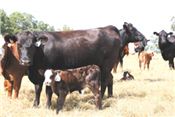|
Grass Tetany Likely To Be Seen Throughout Spring Season Due To Rain, Cool Temps

Heavy lactation and other stressors can cause of a magnesium deficiency in cattle known as grass tetany.
U of Arkansas System Division of Agriculture photo by Tom Troxel
LITTLE ROCK, ARK.
Although the disease known as grass tetany typically peters out by April, Arkansas cattle ranchers should keep an eye out for the disease well into the late spring months this year, due to heavy rains and cool temperature trends in the region.
Tom Troxel, associate department head of Animal Science at the University of Arkansas System Division of Agriculture, said the disease may occur later this spring than normal, and that heavy field fertilization with potassium can affect grazing livestock.
“Grass tetany is caused by an abnormally low level of magnesium in the cow’s body,” Troxel said. “When forages are fertilized heavily with potash, this can decrease the dietary absorption of magnesium in a cow’s gastro intestinal system. Young, rapidly growing forage usually has an increased content of potassium.”
Grass tetany typically occurs in older lactating cows, and more commonly affects cows with very poor body conditions. Other factors that may play a role in the disease are weather – it’s usually cloudy, misty or cold when this disease occurs – and stressors such as hauling, penning or heavy lactation.
Clinical signs associated with this disease range from slight changes in behavior to death. Early in the disease, cattle affected by grass tetany may show signs including decreased appetite, decreased milk production, tendency to stay away from the herd, increased alertness and a stiff or unsteady gait.
As the disease progresses, cattle may become recumbent and unable to get up. They often exhibit muscle tremors, protruding third eyelids, increased pulse and respiratory rates, eventually dying if untreated. If a cattle producer notices any of these signs they should contact their veterinarian immediately.
Producers can prevent grass tetany by providing a salt-mineral supplement of at least 10 percent magnesium, Troxel said. Several mineral feeders should be used if stocking rates are higher for a producer’s herd. Mineral feeders should also be conveniently located in the pasture so cattle have adequate access to them. It is also important to review fertilization practices to minimize the disease’s prevalence. Fertilization should be based on recent soil samples taken on site. For more information about cattle diseases, contact your local county extension office, visit www.uaex.edu, or http://Arkansaslivestockdotcom.wordpress.com. ∆
|
|